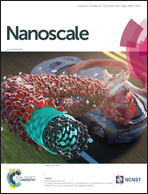Sub-kT/q switching in In2O3 nanowire negative capacitance field-effect transistors†
Abstract
Limited by the Boltzmann distribution of electrons, the sub-threshold swing (SS) of conventional MOSFETs cannot be less than 60 mV dec−1. This limitation hinders the reduction of power dissipation of the devices. Herein, we present high-performance In2O3 nanowire (NW) negative capacitance field-effect transistors (NC-FETs) by introducing a ferroelectric P(VDF-TrFE) layer in a gate dielectric stack. The fabricated devices exhibit excellent gate modulation with a high saturation current density of 550 μA μm−1 and an outstanding SS value less than 60 mV dec−1 for over 4 decades of channel current. The assembled inverter circuit can demonstrate an impressive voltage gain of 25 and a cut-off frequency of over 10 MHz. By utilizing the self-aligned fabrication scheme, the device can be ultimately scaled down to below 100 nm channel length. The devices with 200 nm channel length exhibit the best performances, in which a high on/off current ratio of >107, a large output current density of 960 μA μm−1 and a small SS value of 42 mV dec−1 are obtained at the same time. All these would not only evidently demonstrate the potency of NW NC-FETs to break through the Boltzmann limit in nanoelectronics, but also open up a new avenue to low-power transistors for portable products.



 Please wait while we load your content...
Please wait while we load your content...